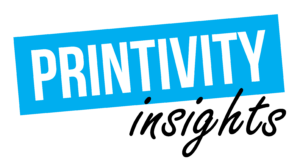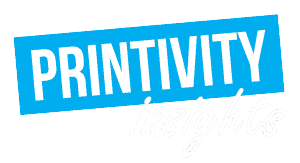Last updated on June 21st, 2024 at 01:24 pm
Since the advent of personal computers, smartphones, and mobile devices, digital marketing has become the primary approach for most companies, especially small businesses on a limited budget. Websites, email, social media, and other digital tools make it cost-effective for small businesses to generate strong marketing results. Contrary to popular belief, digital marketing hasn’t caused the demise of print marketing. In fact, not only do print marketing tools continue to have a place in a comprehensive marketing strategy, their role has become increasingly important in today’s digital world.
Today’s consumers have become inundated with digital marketing messages. According to a study by the U.S. Postal services, print marketing such as flyers, brochures, and direct mail provide respite from the constant inflow of digital media, making printed materials a very effective way to connect with your target market. The study also showed that large numbers of consumers continue to look to print marketing to inform their buying decisions.
At the same time, competition continues to increase in virtually every industry, while consumer attention spans are shorter than ever. Getting your small business to grab people’s attention now requires a mixture of digital and traditional marketing tools, including flyer printing. If you’re thinking about flyers marketing to promote your business, now is the time to get started.

Five good reasons to use a flyer marketing strategy to promote your business
Creating flyers for marketing offers many benefits to small businesses. Five of the most important ones include:
- Low cost. Marketing flyers can produce big results on a small budget. You can save on design costs by doing it yourself; plus printing and distribution costs are minimal.
- Keep the pipeline full. A well designed flyer distributed to the right target audience is a very effective way to attract potential customers, especially for a local business.
- Many different uses. The purpose of a flyer is multifaceted. It can be used to build your brand, promote a new product, announce an upcoming sale or special event, and much more.
- Support your digital marketing. Adding QR codes to flyers allows people to instantly link to more information and make buying decisions using their smartphones.
- Easy to track results. Using flyer numbers, coupon codes, and customer URLs enables you to track the number of responses and purchases precisely.
Perhaps the biggest benefit of flyer marketing is that they are tangible. Flyers provide something to hold in your hand rather than looking at a screen. If a flyer comes in the mail, most people will at least see what it’s about. In contrast, millions of marketing emails go unread every day because they can be instantly deleted at a swipe or click of a button.
A recent survey reported that 88 percent of respondents believe they understand and retain information better when they read print on paper. Seventy-seven percent reported a preference for reading print compared to digital.
How to use flyer marketing strategies to promote your business
As with any marketing tool, promotional flyers have to be done right to get the desired return on investment. The following steps provide a guideline for creating and distributing flyers that get results.
Have a clear purpose in mind. Don’t put out a flyer just because everyone else is doing it. Have a clear goal you want to accomplish, such as generating new leads, driving people to your website, producing sales, etc. Otherwise, you’re not likely to produce any meaningful results.
Get focused. Especially, get focused on two things: your target market and your key message. Flyers don’t work very well with a shotgun approach (sending out large numbers of flyers and hoping that some hit the target). Instead, get very clear on who is likely to be interested in your marketing message and direct the flyer specifically to them.
The same holds true for your message. Focus on one or two key points so that you don’t inundate readers with too much information. For example, suppose your company is having a sale on many different items. Instead of trying to list every item on the flyer, limit it to one or two of your best sellers and most popular products.
If the purpose of your flyer is to announce a special event, such as a storewide sale, limit the information to what people need to know; include the time, date and location, and what’s in it for them (e.g. 50% off all items).
Get creative. In many cases, a flyer may be a consumer’s first introduction to your business, so it’s critical to make a great first impression. Using bold colors, large, compelling headlines, concise, well-written copy, and unique design elements will grab the reader’s attention and encourage them to keep them reading.
Basic flyer design tips include:
- Print as color copies when your flyer contains images. Choose black and white copies when the flyers contains mostly text.
- Use two different fonts at most. Any more and the flyer becomes hard to read.
- Use different size fonts; larger for the headline and subheads, smaller for the body copy.
- Make it easy to read – short, clear sentences with plenty of space between blocks of text so that the flyer doesn’t look crowded.
- Don’t get carried away with too much imagery. A few powerful pictures or graphics will capture the reader’s attention. Too many can make the flyer seem crowded.
Have a strong call to action. A marketing flyer without a powerful call to action is like a race car with no fuel. The flyer needs to provide useful information to your target market. But unless you tell people what to do with that info – visit your website, attend the special event, buy your product, etc. – it won’t achieve the goal you set for the flyer. Make every call to action short, dynamic, and compelling enough to motivate readers to take action.
Put your flyers in the right places.
The final element in using flyers to promote your business is distribution – where, when, and how you get the flyers in front of your target market. Here’s where knowing your market at a deep level makes the difference. Don’t just focus on how old they are or their income level. Dive into other areas such as where they live, where they shop, how they shop, their personal interests, etc.. This kind of information will tell you where to place your fliers so that they will be seen and responded to.
Different ways to distribute flyers as a marketing strategy include:
- Direct mail
- Leave-behinds on sales calls
- Include them with customer invoices and vendor payment
- Door-to-door distribution by hand (in targeted areas)
- Place flyers on cars
- Insert flyers into neighborhood newspapers to reach a local audience
- Hand out to event attendees
- Distribute at trade shows and industry gatherings
- Give out at fairs, festivals, and sporting events
- Insert flyers in packages sent to retail customers
Make sure you have a way to track the results of every flyer distribution. Otherwise, you won’t know which areas and distribution methods produced the best responses.Finally, when using flyers to market your business, don’t scrimp on the printing to save a few bucks. A low-quality print job does not make a good first impression. It also saps the energy out of the flyer. For high-quality flyers that get results, visit Printivity – the marketing flyer experts.










